As a manager, one responsibility you probably have is creating work schedules and managing the work hours of your employees.
Although this is not a very time-consuming task, it is essential that you do it right.
Work scheduling does not have to be confusing, and you don’t necessarily need to go above and beyond to create a perfect schedule.
But where to begin? Your mind must be full of questions, especially if you are new to team management. From What is the perfect work schedule to Can I schedule employees outside their work hours — the concerns you might have are only natural.
Still, it doesn’t have to be like that. We’ll go over each and every question you might have about employee scheduling, discuss different types of work schedules and all the points you need to cover before you issue a schedule.
As a special safety measure — to ensure that everything goes as planned — we’ve prepared 6 free work schedule templates you can download and use as many times as needed.
🔽 Quick access to free downloadable work schedule templates:
- Employee Availability Form Template — Excel, Google Sheets, PDF
- Daily Work Schedule Template — Excel, Google Sheets, PDF
- Weekly Work Schedule Template — Excel, Google Sheets, PDF
- Bi-Weekly Work Schedule Template — Excel, Google Sheets, PDF
- Monthly Work Schedule Template — Excel, Google Sheets, PDF
- Yearly Work Schedule Template — Excel, Google Sheets, PDF

- A work schedule shows the time and days when an employee works. It contains work hours, shifts, work location, and other employee information.
- Work schedules help you operate more efficiently, reduce employee turnover, meet deadlines, and help employees maintain work-life balance.
- There are many types of work schedules, including full-time, part-time, flexible, and shift-based schedules.
- To create a perfect work schedule, you should communicate well with your team, analyze the workload, track employee times, and avoid scheduling mistakes.
- Tools such as shift templates and employee scheduling software can be useful in creating a perfect work schedule.
Table of Contents
What’s a work schedule?
A work schedule (also known as a rota or roster) shows when employees are scheduled to work and gives additional information about their shifts and work hours. Businesses use it to operate more effectively, monitor employee availability, and avoid staffing complications. A typical work schedule contains information such as:
- Work hours,
- Shifts,
- Work locations,
- Responsibilities during the time period covered by the schedule, and
- Other associated employee information.
Creating a schedule for work is referred to as scheduling and is usually carried out by a manager. Many types of businesses require schedules, including:
- Retail stores,
- Manufacturing facilities,
- Restaurants and coffee shops,
- Call centers,
- Businesses with customer/user support teams,
- Businesses that employ freelancers, and
- Businesses that employ seasonal workers.
Why is work scheduling important?
When you think of work schedules, it’s easy to come up with dozens of reasons why they’re necessary right off the top of your head.
But there’s even more to work scheduling than meets the eye — so let’s get right into the benefits of investing some time in creating an employee schedule.
Work scheduling ensures efficient operation
When employees understand their work hours and responsibilities, as well as their work location (in case they perform fieldwork), they are in a position to maximize their productivity.
Work scheduling helps plan work according to employee availability
Proper work planning should be about establishing a work schedule that requires minimum changes along the way.
This is usually achieved when the manager takes into account employee attendance, their expected work hours, and time off requests.
💡 Clockify Pro Tip
Although a great PTO policy does not come out of thin air, there are still tricks for creating a perfect one while wasting minimum energy. Make sure to check out:
Work scheduling eradicates the idea of favoritism
Work schedules make shifts transparent so the team members can see everyone’s shifts/tasks and understand that no one is (hopefully) getting the best shifts/tasks every time.
Work scheduling helps you better manage your time and meet deadlines
Proper time management is important for maintaining high productivity, and work schedules help you organize your workload better — thus making you more productive.
When all the tasks are well organized, none of the employees remain buried under piles of deadlines. Instead, they meet them according to the plan and always keep the workload under control.
Work scheduling helps employees maintain a healthy work-life balance
When employees are aware of when they are scheduled to work, they can plan and balance their work obligations, doctor’s appointments, personal errands, and family activities. This also helps with retaining a healthy work-life balance and keeps your team members’ stress levels lower.
Work scheduling decreases employee turnover
Having a practical work schedule is vital to maintaining employee satisfaction, and this, in turn, decreases your workers’ stress levels. Employees who have low stress levels and feel like they are as appreciated as their colleagues are less likely to leave their jobs.
Work scheduling helps increase customer/client satisfaction
A well-thought-out schedule helps keep the workflow running like clockwork. Moreover, when everything functions smoothly, the customers or clients get the expected quality of service.
An organized schedule is especially beneficial if your business requires you to communicate with customers over the phone — because it can reduce your average handle time and increase your customers’ overall satisfaction.
What are the types of work schedules?
Even though work schedules come in different shapes and sizes, we can still pick out 14 main types of work schedules.
1. A full-time schedule / 40-hour work schedule
A full-time schedule requires employees to work between 35 and 40 hours per week. It is usually tied to job positions whose amount and type of workload require full-time specialists.
Many US states mandate that employees working on full-time schedules receive employee benefits. Most such employees work the same number of days per week and hours per day. However, their exact working hours may be fixed (e.g., 9:00 a.m. – 5:00 p.m.) or flexible (e.g., 8 hours per day, in no fixed order).
Example: An in-house designer scheduled to work 40 hours per week, 8 hours per day, from Monday to Friday.
💡 Clockify Pro Tip
Do you need help creating an 8-hour workday schedule? Check out our article on this topic.
2. A part-time schedule
A part-time schedule requires employees to work less than the full-time equivalent schedule prescribed by the company (e.g., in companies that count 35 hours per week as full-time, anything fewer counts as part-time). It is usually tied to job positions whose type of workload permits several part-time employees to carry it out, or whose amount doesn’t require full-time employment.
Employees with part-time schedules may not get employee benefits usually associated with full-time work. Such schedules may be consistent (e.g., 9:00 – 2:00 p.m. every workday) or not (e.g., 8:00 a.m. – 1:00 p.m. from Mondays to Wednesdays + 1:00 p.m. – 6:00 p.m. on Saturdays and Sundays).
Example: A restaurant hostess who works 25 hours per week in total during the busy times of the day.
💡 Clockify Pro Tip
If you want to learn more about part-time and full-time employment, and see the differences between the two, check out our article on this topic:
3. A fixed schedule
A fixed schedule has a timetable with the same number of working days and hours per week. It may be used for any business requiring employees to work together simultaneously or be at service to customers/clients during fixed open hours. A fixed schedule may involve full-time or part-time work.
Example: A team of HR specialists who are scheduled to work Monday through Friday from 9:00 a.m. to 5:00 p.m.
4. A flexible schedule
A flexible schedule prescribes that an employee needs to work a specific number of flex hours per day as a minimum requirement (e.g., 6 hours). But, the actual hours will depend on the employee’s time of arrival at the workplace (e.g., the employee arrives on Monday at 8:00 a.m. and then works until 2:00 p.m. but they arrive at 9:00 a.m. on Tuesday and then work until 3:00 p.m.).
Such schedules may be full-time or part-time. They may be used for any type of business that does not require employees to work together at the same time or be at service to customers/clients during fixed open hours.
Example: A customer support specialist is scheduled to work 8 hours per day, Monday through Friday, from the moment of arrival to the office.
5. A floating schedule
A floating schedule involves a fixed main part (the employee being at the disposal of the employer) and a variable, “floating” part (the employee can choose their start and end times during the workday).
In practice, floating schedules have been in use for some time. But, they were only given a legal framework with the introduction of the “Flexible and Workable” act (FWW-act) — at least in Belgium.
Example: A maintenance technician is scheduled to replace a vital part of an ice-cream machine after every 20,000 gallons of ice-cream created, which happens every two weeks. While the ice-cream machine maintenance is a fixed assignment that occurs every two weeks, the maintenance technician performs other work in the meantime.
6. A shift-based schedule
A shift-based schedule is usually implemented in businesses that operate for 10 or more hours per day. If a business operates 24/7, they usually implement a three-shift approach — employees always work or take turns working:
- The first shift (morning shift),
- The second shift (afternoon shift), and
- The third shift (night shift).
Example: 3 gas station attendants who take turns working in three shifts (7:00 a.m.– 3:00 p.m.; 3:00 p.m. – 11:00 p.m.; 11:00 p.m. – 7:00 a.m.) Monday through Thursday.
7. A seasonal schedule
A seasonal schedule may be shift-based, flexible, fixed, part-time, or full-time, but it is limited to a specific season or time period (e.g., the winter holiday season in November and December).
Example: Two Santa Clauses scheduled to work in a shopping mall throughout November and December in two shifts (Shift 1: 8:00 a.m. – 2:00 p.m.; Shift 2: 2:00 p.m. – 8:00 p.m.).
💡 Clockify Pro Tip
Certain industries require a different amount of work during particular seasons. For many, this is a great opportunity to get additional work. Learn more about seasonal work in our guide.
8. An overtime schedule
An overtime schedule involves working more than the standard 40 hours per week. Depending on the day or length of overtime, but also the US state where the worker is employed, overtime is paid either 1.5 or double the regular employee rates. However, only employees not exempt from the Fair Labor Standards Act (FLSA) are entitled to overtime pay.
Example: A waiter scheduled to work 45 hours in one week — the 5 extra hours scheduled are considered overtime.
💡 Clockify Pro Tip
Do you need assistance with calculating overtime work hours? Our free overtime calculator can help you.
9. A compressed schedule
A compressed schedule involves working the traditional 35-40 hours per week but in fewer days.
Example: A window washer scheduled to work 40 hours per week, 10 hours per day (7:00 a.m. – 5:00 p.m.) Monday through Thursday.
10. A rotating schedule
A rotating schedule is usually tied to shift-based work. Employees are assigned rotating shifts based on a predefined pattern, usually on a weekly or daily basis.
Example: A doctor working in the ER is scheduled to work 12-hour day shifts on Mondays and Saturdays and 12-hour night shifts on Tuesdays and Sundays. Wednesdays, Thursdays, and Fridays are off.
11. A split schedule
A split schedule involves parsing a workday into three distinct points:
- Working for a few hours in one go,
- Having several hours off, and
- Working for another set of hours after the “break.”
Example: A taxi driver scheduled to work from 5:00 a.m. to 9:00 p.m., takes a break from 9:00 a.m. to 2:00 p.m., and then starts working again from 2:00 p.m. to 9 p.m.
12. An on-call schedule
An on-call schedule involves employees being available during specific times of day, or days in general, when they may, or may not be called in to work.
Example: A firefighter scheduled to work on-call needs to be in a 5-minute vicinity from the fire station during the scheduled days.
13. 9/80 work schedule
A 9/80 work schedule is a variation of a compressed schedule as it includes 80 work hours spread over 9 days rather than the usual 10 days. With this schedule, employees have an additional day off every second week in addition to the weekend.
In the first week, employees work 9 hours Monday through Thursday and 8 hours on Friday, which equals 44 work hours.
In the second week, they work 9 hours Monday through Thursday and have a day off on Friday, which equals 36 hours (44+36=80). Employees can choose when to have a day off during the second week.
Example: Clif Bar is a company that offers this type of schedule. They believe that it creates a healthy, stress-free work environment and allows employees to do things they enjoy and spend time with their families.
14. 4/10 work schedule
This shift schedule includes 4 working days on which employees are expected to work 10 hours. Since a 4/10 work schedule is considered a compressed schedule, after finishing a 10-hour shift 4 days in a row, employees usually have an extra day off (on top of the traditional 2) they can use to recover and rest.
Example: A 4/10 work schedule can be used in many industries. For example, a web developer can work for 10 hours a day, Monday through Thursday, and have a day off on Friday.
💡 Clockify Pro Tip
If you want to learn more about a 4-day work week, check out our article on this topic:
How best to create work schedules?
Creating a proper work schedule requires careful preparation — at least if you want to avoid having to make additional changes and disrupting your team’s productivity.
That’s why we’ve carefully outlined each step you need to take to create a perfect work schedule for your team.
#1: Make the time to understand your team
You may think that having enough people during a shift is enough for success. But you’ll also need to ensure they are the right people for the type of tasks, amount of workload, time of day, or type of customers.
So, the first real step in creating efficient work schedules is knowing your team. Make a list that includes their:
- Relevant skills,
- Personal qualities such as perseverance, efficiency, or reliability,
- Certifications, relevant education, experience,
- Their employment status (are they full-time or part-time?),
- Personality type (are they introverted or extroverted?), and
- Work habits, especially if you have flexible schedules, and some employees have the habit of arriving sooner than others.
With such a list, you’ll be able to pick the ideal teammates for each shift/task.
Example: Tasking the extroverted full-stack developer, who tends to come in later and finish work later, with the 5:00 p.m. daily call with a client who’s just starting her workday due to the time zone difference.
#2: Make the time to analyze the workload
Now that you understand the skills, qualities, and traits of each team member, it’s time to analyze the workload and the resources you have to handle it.
One option is to make a chart of workdays and hours your team has at their disposal. For example, if you operate on a flexible, 8-hour schedule Monday through Friday, your team members will have 40 hours each to carry out their work.
Then, you can identify the busy hours or the most important tasks that need to be done, and schedule your most needed specialists accordingly.
Alternatively, you can always stay in the loop with everyone’s availability and workshare by using Clockify’s project and team scheduling feature.
You can either look at separate projects and see who’s actively involved in them, or check up on individual team members and quickly figure out who is overbooked, who is working over capacity, and who is available.
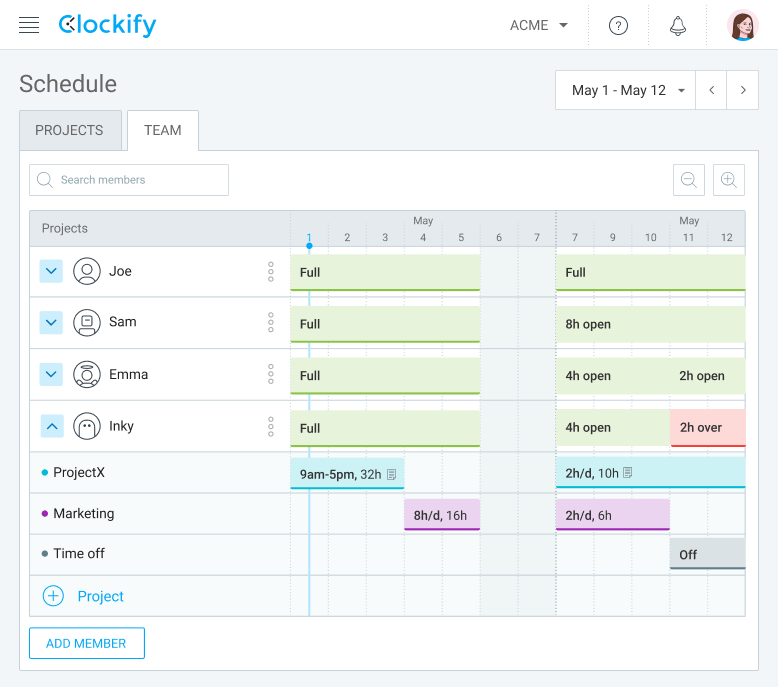
#3: Track employee clock-in and clock-out times
Not only does recording employee time help track the overtime hours (if your business authorized overtime), but it also provides the employees with a clear log of the hours worked.
Before setting up your work schedules, you’ll need to instruct your employees on how to track their clock-in and clock-out times. For this purpose, you can use an employee time clock app which helps you define your projects and assign tasks to each team member.
Once all the tasks are distributed, your team members can keep track of their progress in 2 ways:
- By tracking time in the timer mode, and
- By adding time manually.
If you’d like to track time by using the timer, just have everyone start/stop the timer as they start working/finish work on an assigned task/today’s shift.

In case you’d like to instruct your team to log their time manually, all they need to do is add a time entry by specifying their start/end times for each assigned task/shift.

Alternatively, they can also add their times in a timesheet — just have everyone add shift duration for each day in a weekly timecard.

All the time entered can later be viewed in weekly reports that can assist you in creating even better schedules in the future.
If your employees log billable hours, you can also use Clockify data for payroll — since the tracker will automatically calculate how much you need to pay employees based on their tracked time.
💡 Clockify Pro Tip
To learn more about how best to set up and carry out a clock-in clock-out system, check out our detailed blog post about it:
#4: Follow a set of rules to schedule employees fairly
Although there’s still much to be done to ensure employees can maintain a healthy work-life balance, Predictive Scheduling Laws are one step further in protecting employees from overworking.
These laws mandate certain scheduling practices to be followed, such as an advance notice of work schedule.
In case the employee was not timely notified about their upcoming schedule, they receive a guaranteed predictability payment.
There are only a few cities in the US enacting these laws (e.g., Chicago, Emeryville, Los Angeles, Philadelphia, New York City, Evanston, San Francisco, Seattle, and others), and only certain industries (e.g., food service, retail, and hospitality).
However, the 10 scheduling rules prescribed by these laws can be a great addition to any scheduling practice and improve its effectiveness:
- Rule #1 — provide “Good faith estimates” for the schedules of all new hires,
- Rule #2 — have employees state their work time/day and location preferences,
- Rule #3 — notify employees in advance about their work schedules,
- Rule #4 — offer additional hours to existing employees before hiring someone new,
- Rule #5 — notify employees about their work schedule changes,
- Rule #6 — offer premium pay for schedule changes you’ve had to make without timely notice,
- Rule #7 — provide a rest period between two employee shifts unless the employee agrees to work during this time,
- Rule #8 — keep the records of previous schedules for future reference,
- Rule #9 — have a list of schedule-related rights posted at the workplace and/or easily accessible online, and
- Rule #10 — don’t retaliate against the employee for trying to enforce schedule-related employee rights.
#5: Establish an efficient team communication system
One of the keys to team productivity and proper employee time management is ensuring the team feels connected and well-informed about recent developments, updates, or changes to the expected workflow or workload.
So, make sure you always communicate any changes related to the work schedules and give everybody a chance to reach out to you with their own questions and requests.
Of course, to manage all this communication, you’ll need to establish a well-organized communication system, which may involve:
- Business messaging apps — that let you schedule messages and plan all your meaningful conversations ahead,
- Text messages — for sending short texts for matters you need to communicate, but are otherwise not urgent,
- Phone calls — this way you can call up people when you need a quick confirmation for something that cannot wait,
- Emails — for all the messages that can wait a bit longer. You can also pair up your email provider with an AI email writer to speed up your email writing process, and
- Online video meetings — whenever you need to share your screen or notes while talking with your teammates.
To establish an efficient communication system, don’t forget to:
- Notify the employees as soon as you’ve finished and posted the newest work schedule,
- Let everyone know about last-minute schedule updates or unexpected additional obligations, and
- Clearly state that your team needs to inform you whenever they swap shifts or take up additional tasks since these changes could influence further scheduling.
💡 Clockify Pro Tip
Good old face-to-face communication is almost outshined by the swiftness of team chat apps. If you’re looking for a way to quickly inform your remote team about their upcoming schedule, make sure not to miss out on:
#6: Post the work schedule at least 7 days in advance
In line with Predictive Scheduling Laws, employers must post new work schedules between 7 and 14 days prior to the first scheduled shift. However, as we’ve previously discussed, these laws are mainly enacted in certain cities because they fall under local ordinances.
Federal employment laws, such as the Fair Labor Standards Act, allow employers to change schedules without prior notice.
Still, when you inform your team members about their schedules days in advance, you should leave enough time in case someone:
- Needs to schedule (or reschedule) personal commitments to accommodate the new work schedule,
- Wants to find a substitute or trade shifts (you can either let employees trade shifts or have a system for substitutes), and
- Wants to talk to you about the days or times they work (perhaps you’re always scheduling employee X on times and days that never work for them).

If you’re using Clockify for scheduling, you can easily notify coworkers about their work hours and any potential changes in the work schedule.
Posting a work schedule in advance decreases the possibility of employees not knowing their shifts and assignments.
#7: Avoid common scheduling errors
When scheduling, make sure you don’t:
1. Double-schedule employees who have dual responsibilities, but in the same shifts — sometimes, your employees may have several responsibilities, so it’s necessary to avoid double-scheduling their shifts. This is quite common in the hospitality industry, where, for example, a person who works as both the hotel hostess and a busser may accidentally get double-scheduled.
2. Schedule staff for the position they were not trained to fill — regardless of how large or small a business you own, there’s always the risk of scheduling some of your staff to fill in the duties they are not trained to complete. You could, for example, schedule a Customer Success agent to perform the duties of the Customer Support agent — so make sure to double-check everything before making the work schedule public.
3. Under-schedule or over-schedule your employees, in terms of their work hours — if you employ both part and full-time employees, you’ll need to be extra careful not to schedule anyone with too many shifts or too few shifts.
4. Under-schedule or over-schedule your employees, in terms of the expected workload — if you don’t keep track of your company’s workload, you may end up understaffed during your busy hours.
💡 Clockify Pro Tip
Overworking usually brings more harm than good, but sometimes it goes unnoticed. Find out why recognizing this issue should be your top priority:
#8: Honor work preferences and requests for time off as much as you can
High employee satisfaction means higher productivity. In addition, the best way to get high employee satisfaction is to let the employees know they are being heard by the management.
So, if certain employees prefer to work on certain hours or days, accommodate them if possible.
Or, when an employee asks for time off, try to agree to their request whenever possible.
Moreover, you should always implement a clear system for employees asking for preferred schedules and time off. This way, you’ll make the request approvals/denials transparent, making it clear there is no favoritism.
If you and your team are using Clockify to track work hours and plan tasks in advance, you can set a time off policy and approve your team’s time off requests on the spot.

Using Clockify as a time off and vacation tracker also gives you accurate insight into everyone’s availability and upcoming leaves so that you can schedule their work time accordingly.
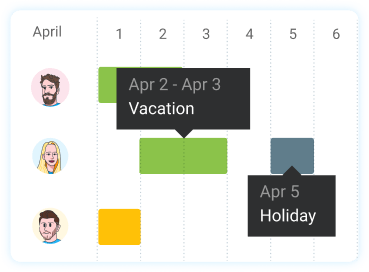
#9: Schedule at least one top-notch employee per shift
If your business operates in shifts, make sure that each shift features at least one of your top players in terms of relevant employee skills, expertise, experience, and personal qualities. This will vastly improve the shift’s quality and the customer experience. Moreover, the less-experienced employees (especially the newly hired ones) will have someone to look up to in terms of work standards or turn for support when needed.
Having one of your best employees is especially relevant during busy times when you want someone reliable at the scene to “pull” the workload and inspire other teammates to keep up the pace.
Example: Scheduling a reliable food service specialist to operate the cash register, serve customers, and stock supplies during lunchtime in a city’s business district.
#10: Involve the employees in the scheduling process
You probably don’t want to waste time on constant work schedule updates because your employees always ask for shift swaps or deadline extensions.
To minimize this, you can aim to involve the employees in creating work schedules as much as you find suitable.
1. Have someone assist you in scheduling
Colleagues are more likely to understand what their co-workers think about their schedules, so having someone from the “inside” directly assist you with the schedules is optimal. This way, you’ll find out whether members of your team:
- Are satisfied with their appointed times,
- Want more or less time scheduled per week, or
- Prefer other days or times for their schedules.
2. Have the team fill out availability charts
With an availability chart, all employees need to do is mark the days when they are available to work during a certain week. Later on, you’ll use this data to create feasible work schedules.
Example: You schedule someone for the first shift, but they are not available to work during this time. You glance at the availability chart and find the next suitable employee who marked their availability during the required time. You may even find that you’d have a backup for your backup if a larger number of employees is available.
3. When scheduling outside the available times, consult first
Sometimes, despite all the efforts the team has made with the availability chart, you’ll still need to schedule someone outside their availability times.
Example: Perhaps there’s a big celebration being hosted at your restaurant and you’ll need all hands on deck. Or, perhaps, there’s an unexpected bug in your app, and you need to call in your full-stack engineer to assist you from their vacation.
Emergencies happen, but it’s important how you approach them. If possible, always try to find the person who’d be the least inconvenienced by working outside their ideal availability times.
Example: If you have to choose between two options, always go for the person who is unavailable because of their spa appointment instead of calling a team member who is at the hospital worried about their family member.
Either way, it’s always best to call up the person in question, explain the situation, and be courteous about the request. A reliable, conscientious employee will oblige your request if possible and appreciate a say in this.
Still, try to be understanding if an employee is genuinely not able to agree to your request, e.g., they have a doctor’s appointment.
#11: Use work schedule templates to speed up the scheduling process
The previous 10 points are designed to help you effectively schedule employee time — but, schedule templates will help you make the scheduling process faster and more accurate. Here are 6 work schedule templates you can use now, for free:
- Employee Availability Form Template
- Daily Work Schedule Template
- Weekly Work Schedule Template
- Bi-Weekly Work Schedule Template
- Monthly Work Schedule Template
- Yearly Work Schedule Template
If you are downloading the Google Sheets template, all you need to do is click the download link and then click on “Make a copy” when a new window opens. For PDF templates, simply click on the download link, and a copy will be automatically downloaded to your device.
Employee Availability Form Template
The Employee Availability Form Template allows your team to share their available hours with you — so that you can schedule their work time accordingly.
How to use the Employee Availability Form Template?
The employees should mark the time they can come to work and/or be on-call duty with checkmarks (Google Sheets) or “X” (Excel).
Alternatively, you can print the forms and have the employees fill them out with a pen.
Later, you can use these employee availability forms to create feasible schedules.
Who is the Employee Availability Form Template for?
This scheduling form is perfect for any type of business that revolves around scheduling.
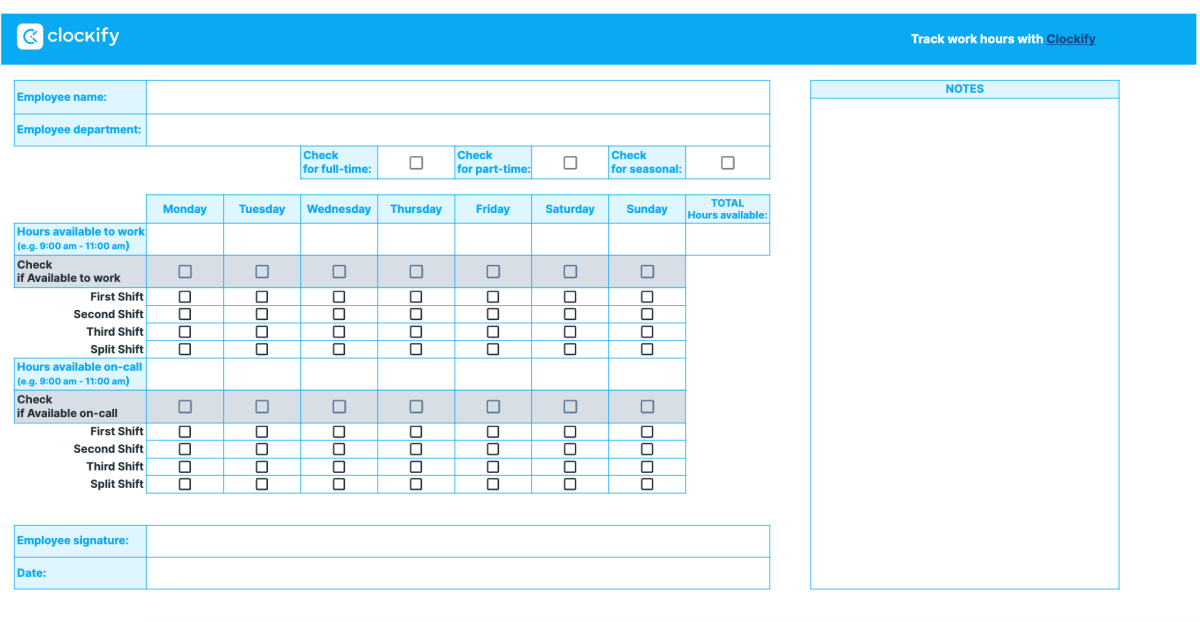
⬇️ Download the classic Employee Availability Form Template in Excel
⬇️ Download the online, shareable Employee Availability Form Template in Google Sheets
⬇️ Download the printable Employee Availability Form Template in PDF
Daily Work Schedule Template
The Daily Work Schedule Template lets you schedule both work hours and tasks for each workday.
How to use the Daily Work Schedule Template?
Simply insert the employee’s name, their department, the date, and add a checkmark (Google Sheets) or “X” (Excel) next to each hour they’re scheduled to work.
Alternatively, you can print the schedule and fill it out with a pen.
Who is the Daily Work Schedule Template for?
This template is perfect if you prefer to schedule work hours and tasks daily.
In case you need to stay compliant with the rule of scheduling work at least 7 days in advance, you can combine this more detailed, task-oriented schedule with schedules that cover a more extensive time period.
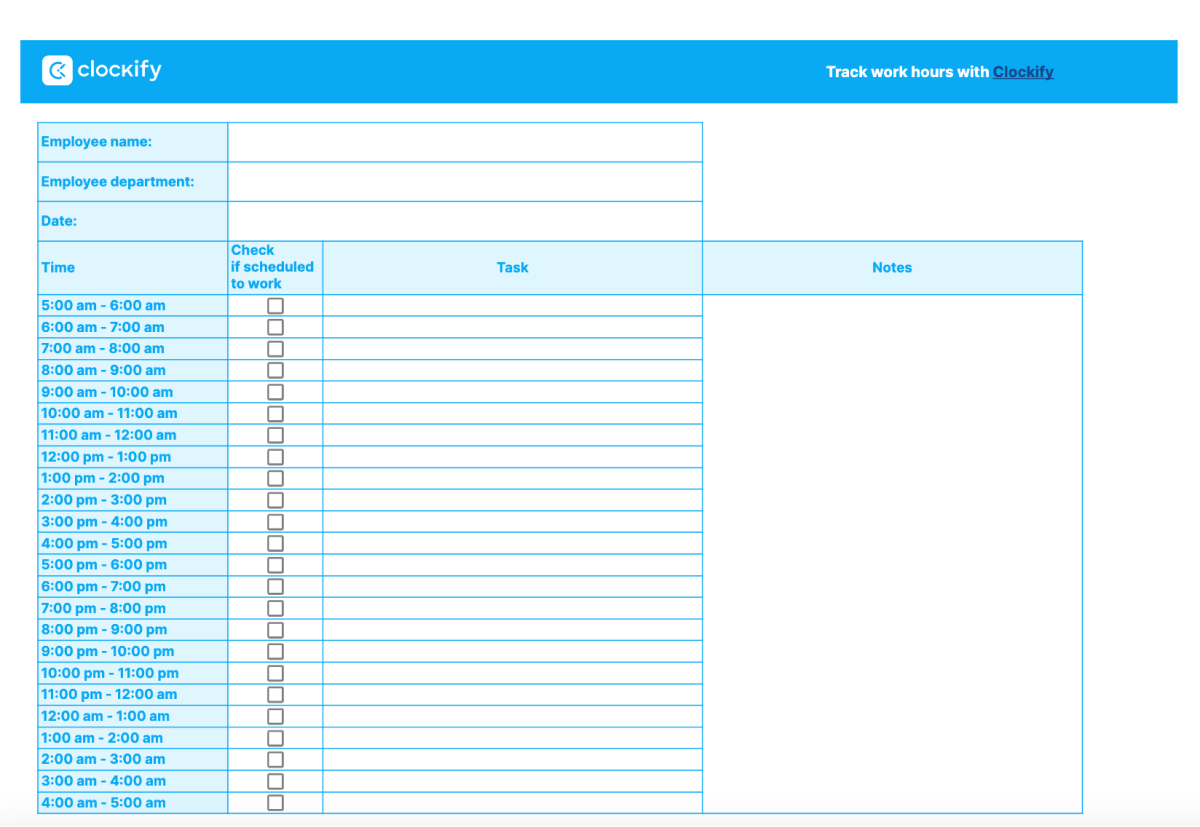
⬇️ Download the classic Daily Work Schedule Template in Excel
⬇️ Download the online, shareable Daily Work Schedule Template in Google Sheets
⬇️ Download the printable Daily Work Schedule Template in PDF
Weekly Work Schedule Template
The Weekly Work Schedule Template lets you schedule the employees’ work days and shifts weekly.
How to use the Weekly Work Schedule Template?
Simply add the employee names and an “X” or a checkmark under each day they are scheduled to work.
The Google Sheets and Excel versions of the template also calculate the daily statistics per employee in terms of:
- How many times individual employees have been scheduled to work per week, and
- How many times they were scheduled to work the First, Second, Third, or Split shift (if applicable).
Alternatively, you can print the schedule and fill it out with a pen.
In case your employees work different split shifts, work overtime, or have specific requests regarding their schedules, you can clarify this below each employee row.
Who is the Weekly Work Schedule Template for?
This template is perfect if you prefer to schedule work days weekly, and/or pay your employees every week.
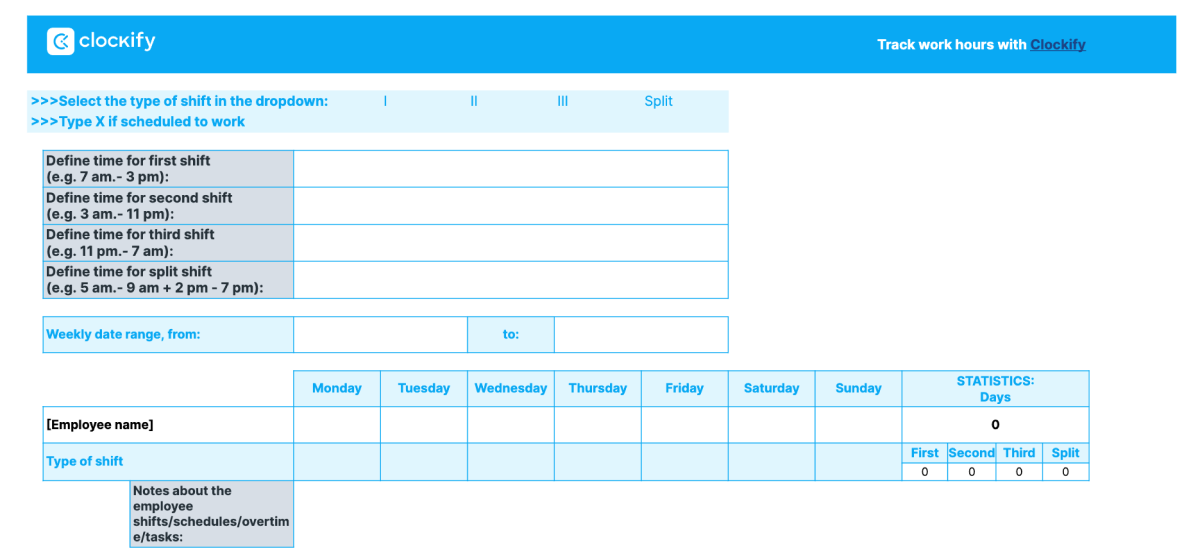
⬇️ Download the classic Weekly Work Schedule Template in Excel
⬇️ Download the online, shareable Weekly Work Schedule Template in Google Sheets
⬇️ Download the printable Weekly Work Schedule Template in PDF
Bi-Weekly Work Schedule Template
The Bi-Weekly Work Schedule Template gives you the option to schedule both the employees’ work days and shifts on a bi-weekly basis.
How to use the Bi-Weekly Work Schedule Template?
Simply add the employees’ names and add an “X” or a checkmark for each day they are scheduled to work.
The Google Sheets and Excel versions of the template also calculate the daily statistics per employee in terms of:
- How many times individual employees have been scheduled to work every two weeks, and
- How many times they were scheduled to work the First, Second, Third, or Split shift (if applicable).
Alternatively, you can print the schedule and fill it out with a pen.
In case your employees work different split shifts, work overtime, or have specific requests regarding their schedules, you can clarify this below each employee row.
Who is the Bi-Weekly Work Schedule Template for?
This template is perfect if you prefer to schedule workdays on a bi-weekly basis, and/or pay your employees bi-weekly.
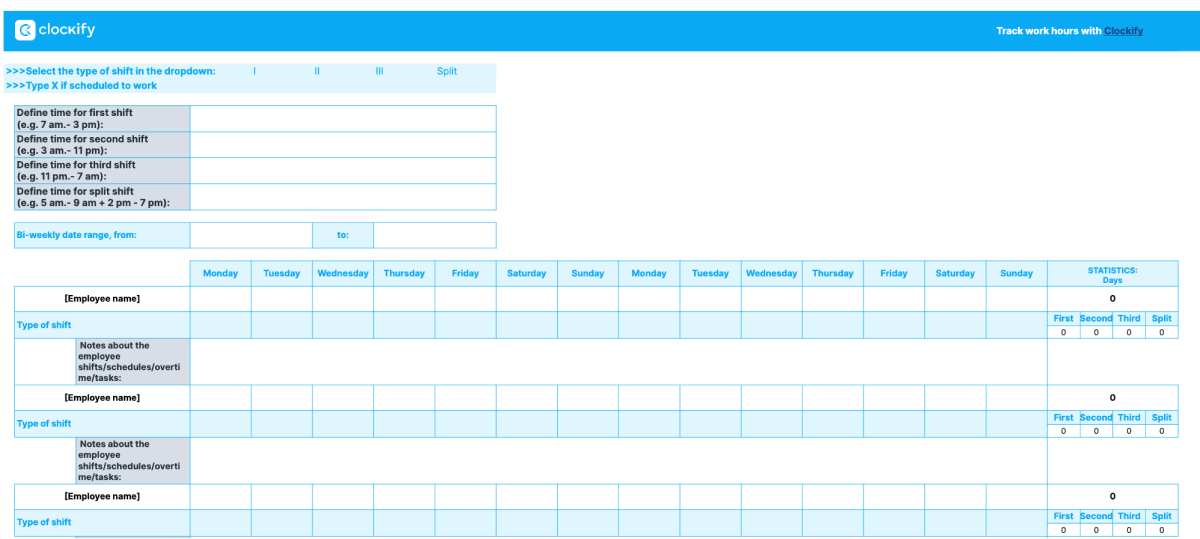
⬇️ Download the classic Bi-Weekly Work Schedule Template in Excel
⬇️ Download the online, shareable Bi-Weekly Work Schedule Template in Google Sheets
⬇️ Download the printable Bi-Weekly Work Schedule Template in PDF
Monthly Work Schedule Template
The Monthly Work Schedule Template lets you schedule both the employees’ work days and shifts for each date on a monthly basis.
How to use the Monthly Work Schedule Template?
Simply add the employee names, and an “X” or a checkmark under each date they are scheduled to work.
The Google Sheets and Excel versions of the template also calculate the daily statistics per employee in terms of:
- How many times individual employees have been scheduled to work per month, and
- How many times they were scheduled to work the First, Second, Third, or Split shift (if applicable).
Alternatively, you can print the schedule and fill it out with a pen.
In case your employees work different split shifts, work overtime, or have specific instructions regarding their schedules, you can clarify this below each employee row.
Who is the Monthly Work Schedule Template for?
This template is perfect if you prefer to schedule workdays on a monthly basis, and/or pay your employees every month.

⬇️ Download the classic Monthly Work Schedule Template in Excel
⬇️ Download the online, shareable Monthly Work Schedule Template in Google Sheets
⬇️ Download the printable Monthly Work Schedule Template in PDF
Yearly Work Schedule Template
The Yearly Work Schedule Template lets you schedule 5 employees over the course of one year (or several weeks or months).
How to use the Yearly Work Schedule Template?
Simply name your employees and associate each with a symbol (“x1”, “x2”, “x3”, “x4”, “x5”).
Write the appropriate symbol (e.g., “x1” for employee 1) next to the suitable date to schedule an employee.
Who is the Yearly Work Schedule Template for?
This template is perfect if your team operates on a rotating schedule or you manage seasonal workers. It can also be a great choice if you prefer to view and plan the workweeks on a larger scale.
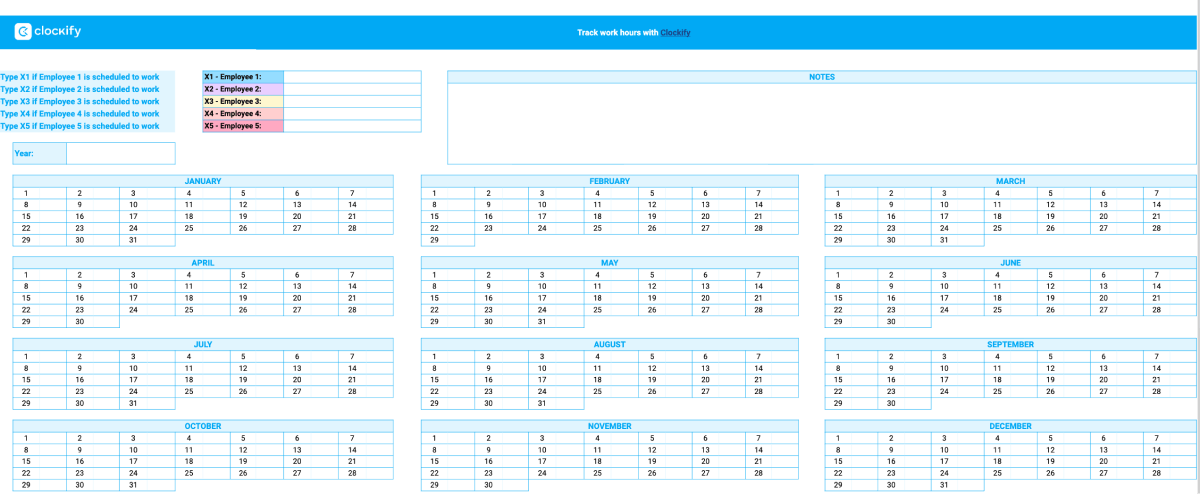
⬇️ Download the classic Yearly Work Schedule Template in Excel
⬇️ Download the online, shareable Yearly Work Schedule Template in Google Sheets
⬇️ Download the printable Yearly Work Schedule Template in PDF
Clockify helps you create a perfect work schedule
Scheduling employee time effectively should not be a challenge — if you take your time to follow through with all the steps we’ve listed above. Yet, since you’ll need to invest quite some time into devising a fully-functional work schedule, having a dedicated scheduling system can help you skip a few steps along the way.
This is where Clockify comes in.
Clockify is a renowned software that can assist you in staff scheduling and time tracking, allowing you to organize your work and oversee all your projects.
With this tool, you can:
- Create shifts,
- Optimize work schedules,
- Monitor your teams’ availability,
- Manage employee time off, and
- Visualize projects.

Its user-friendly interface makes it easy to set up projects, create assignments, track work shifts, and see who works on what.
After all, work scheduling doesn’t have to be that complicated.


